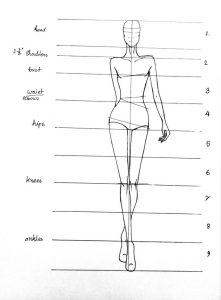Fashion Figure Drawing Demystified
Fashion figure drawing is a fundamental skill in the world of fashion design. It involves creating illustrations or sketches of human figures to showcase and visualize clothing designs. Here are some key steps and tips for fashion figure drawing:
- Start with Basic Proportions: Begin by drawing a simple, elongated oval shape for the head, followed by a vertical line for the body’s centerline. This will help you maintain proper proportions. Read about Artistic Expressions
- Understand Body Proportions: Fashion figures often have elongated and exaggerated proportions. Typically, the idealized fashion figure is around 8 to 9 heads tall, with longer legs and a slender body compared to real-life proportions.
- Pose and Gesture: Decide on the pose and gesture of your fashion figure. Dynamic and expressive poses can make your designs more appealing. You can use reference photos or fashion magazines for inspiration.
- Basic Anatomy: Learn the basics of human anatomy, especially the skeletal structure and muscle groups, as this will help you create more realistic and anatomically correct figures.
Also read the Article: Refining Your Elegance

- Construct the Torso: Add the torso shape by drawing two curved lines for the chest and hips. These lines create the waistline, which is usually narrower than the bust and hips.
- Define Limbs: Sketch in the arms and legs, keeping in mind the exaggerated proportions. Pay attention to the bends and curves in the limbs to create a sense of movement and flow.
- Facial Features: Add facial features like eyes, nose, mouth, and hair. Fashion illustration often simplifies facial details, focusing more on the overall look and style.
- Hands and Feet: Drawing hands and feet can be challenging. Simplify them with basic shapes and use reference images to improve your accuracy.
- Clothing Details: Once your fashion figure’s basic structure is complete, you can start adding clothing details. Pay attention to fabric folds, textures, and how the clothing drapes on the body.
- Incorporate Your Design: Showcase your fashion design by drawing it onto the figure. Consider how the clothing fits and flows on the body.
- Use Appropriate Materials: You can use various materials for fashion figure drawings, such as pencils, markers, watercolors, or digital tools. Choose the medium that suits your style and preferences.
- Practice Regularly: Like any skill, fashion figure drawing improves with practice. Create a sketchbook dedicated to fashion illustrations and experiment with different poses, styles, and clothing designs.
- Study Fashion Illustrators: Look at the work of renowned fashion illustrators to gain insights into different techniques and styles. Analyze their use of lines, colors, and details.
The Basics of Fashion Figure Drawing
Before we dive into the intricacies of fashion figure drawing, let’s establish a strong foundation:
Understanding Proportions
To create stunning fashion illustrations, you must grasp the concept of proportions. Learn how to elongate the figure to achieve that runway-ready look.
Tools of the Trade
Discover the essential tools every fashion illustrator should have in their arsenal. From pencils to tracing paper, we’ll guide you through your shopping list.
Sketching the Fashion Figure
Now that you have your tools ready, it’s time to put pencil to paper and start sketching:
Basic Body Shapes
Learn to sketch the basic body shapes that serve as the foundation for your fashion figures. From hourglass to pear-shaped, explore the diversity of body types.
The Croquis Technique
Master the art of croquis—a simplified outline of the human figure that serves as your canvas. We’ll show you how to create your croquis templates.
Adding Style and Detail
With the basics covered, let’s add some flair to your fashion figures:
Designing Garments
Explore the creative process of designing clothing for your fashion figures. From dresses to accessories, it’s time to unleash your inner fashionista.
Fabric Draping and Texture
Learn how to add depth and realism to your illustrations by understanding fabric draping and texture techniques.
The Art of Coloring
Color plays a crucial role in fashion illustration:
Choosing the Right Color Palette
Discover how to select the perfect color palette that complements your designs and sets the mood for your illustrations.
Watercolor vs. Digital Coloring
Explore the pros and cons of traditional watercolor and digital coloring techniques, and decide which suits your style best.
Bringing Your Fashion Figures to Life
Your fashion figures are almost ready to strut down the runway:
Adding Facial Features
Learn how to add facial expressions and features to give your fashion figure personality and charm.
Creating Dynamic Poses
Explore dynamic poses that can convey movement and attitude in your fashion illustrations.
Conclusion
Fashion figure drawing is a captivating art form that allows you to express your creativity and design vision. By following the steps outlined in this guide, you’ll be well on your way to becoming a proficient fashion illustrator. Remember, practice makes perfect, so keep honing your skills and watching your artistic talents flourish.
FAQs
Q. What is the importance of fashion figure drawing for aspiring designers?
A. Fashion figure drawing helps designers visualize their ideas, experiment with designs, and communicate their vision effectively.
Q. Do I need formal art training to excel in fashion figure drawing?
A. While formal training can be beneficial, anyone can learn fashion figure drawing with dedication and practice.
Q. What are some recommended resources for learning fashion figure-drawing techniques?
A. Books, online tutorials, and fashion illustration courses are excellent resources for learning and improving your skills.
Q. Can I use digital tools for fashion figure drawing, or is traditional sketching better?
A. Both digital and traditional methods have their merits. The choice depends on your personal preferences and goals.
Q. How long does it typically take to become proficient in fashion figure drawing?
A. Becoming proficient varies from person to person. Consistent practice and a passion for the art will speed up your progress.
